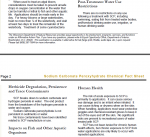I have not used it but others here use it. Think someone here posted this awhile back and I saved it and added other info to it as I got it. Supposed to kill string algae, get rid of tannins, and other yucky stuff.
You can buy it on Ebay either kosher or not. Don't know what the difference is between them.

Sodium Percarbonate Sodium percarbonate can be purchased (without the fancy "use me in your pond" packaging) for 1/10th the price. Just google it. I buy it from a soap making supplier. Same stuff that's sold as waterfall and rock cleaner - and also will clean algae off your patio, roof, etc. And yes, it's perfectly safe - breaks down into hydrogen peroxide and soda ash when it comes in contact with water. I do not expect the percarbonate to have a noticeable effect on a mature biofilter. Reduce the application rate for situations where there is less for the sodium percarbonate to control, probably to a few tablespoons per 1000 gallons per week instead of the 2 pounds per 1000 gallons per week I used to clean up my dirty water garden ponds here at the end of winter and the start of spring. The stringy algae dies and in about a day starts breaking loose. You gotta net out the dead algae at this point or it will plug whatever your mechanical filter system may be. But it has a quite different character than live stringy algae and is much easier to net and remove from the pond. The sodium carbonate will become entangled in the stringy algae then start to hydrolyze making a high concentration of hydrogen peroxide at the strings of algae, and then the algae dies. This takes a few hours, and you will see "bubbling action" from the action of the hydrogen peroxide on the stringy algae. I did not bother using a spoon, I just poured the sodium percarbonate straight from the 2 pound jar onto the stringy algae from above. Worked for me in these two "water garden" ponds, deeper ponds may need a different solids distribution technique. The sodium percarbonate does not immediately dissolve, that is a good thing since you want it to hydrolyze and make the hydrogen peroxide on the stringy algae itself. You will see the pond water start to clear of the "clouds" of stringy algae by the second day as you remove the dead algae. Also, any dead crud on the botton floats to the top to be easily netted out of the pond. A good thing, IMO. The filters were on, and had been on all Winter, and are oversized for the load, in both of the ponds where I have been using sodium percarbonate to clean the pond and kill the algae. Certainly sodium percarbonate should NOT be used in a pond with no circulation or filter system. I don't like the stringy algae. It is ugly, and makes a pond ugly, and the purpose of the pond is to be something lovely and relaxing in my yard. So out will come the sodium percarbonate if I have a serious string algae problem. Sodium percarbonate clears up the brown color in tanins in the water. So, YES, it does that. The LC50 (dose at which 50% of the fish die if the dose remains active for two days and has nothing to react it away) of sodium percarbonate is 0.6 pounds per 1000 gallons. If there is something there like stringy algae or bottom yuck in the pond the hydrogen peroxide will be all gone in a few hours, so I indeed dosed my dirty water garden ponds with an initial dose of a pound per 1000 gallons, then used another pound per 1000 gallons the rest of the week to complete the cleanup. Don't use a pound per 1000 gallons in a relatively clean pond, it would be too much. If the brown color isn't gone, there is still stuff to consume the sodium percarbonate and its reaction product hydrogen peroxide.



